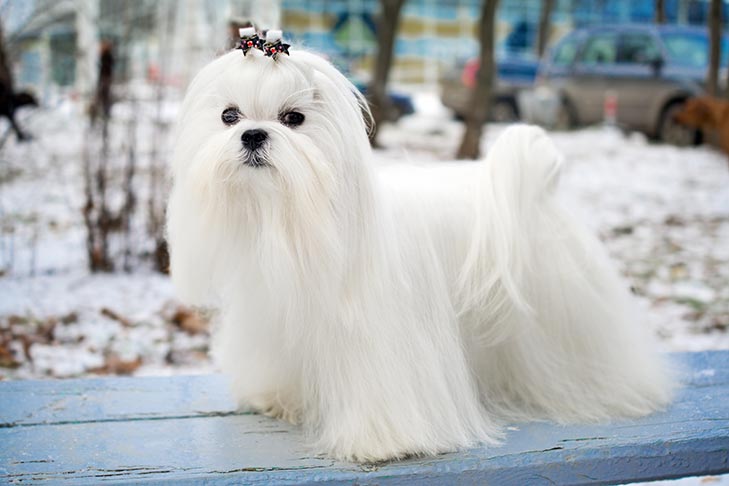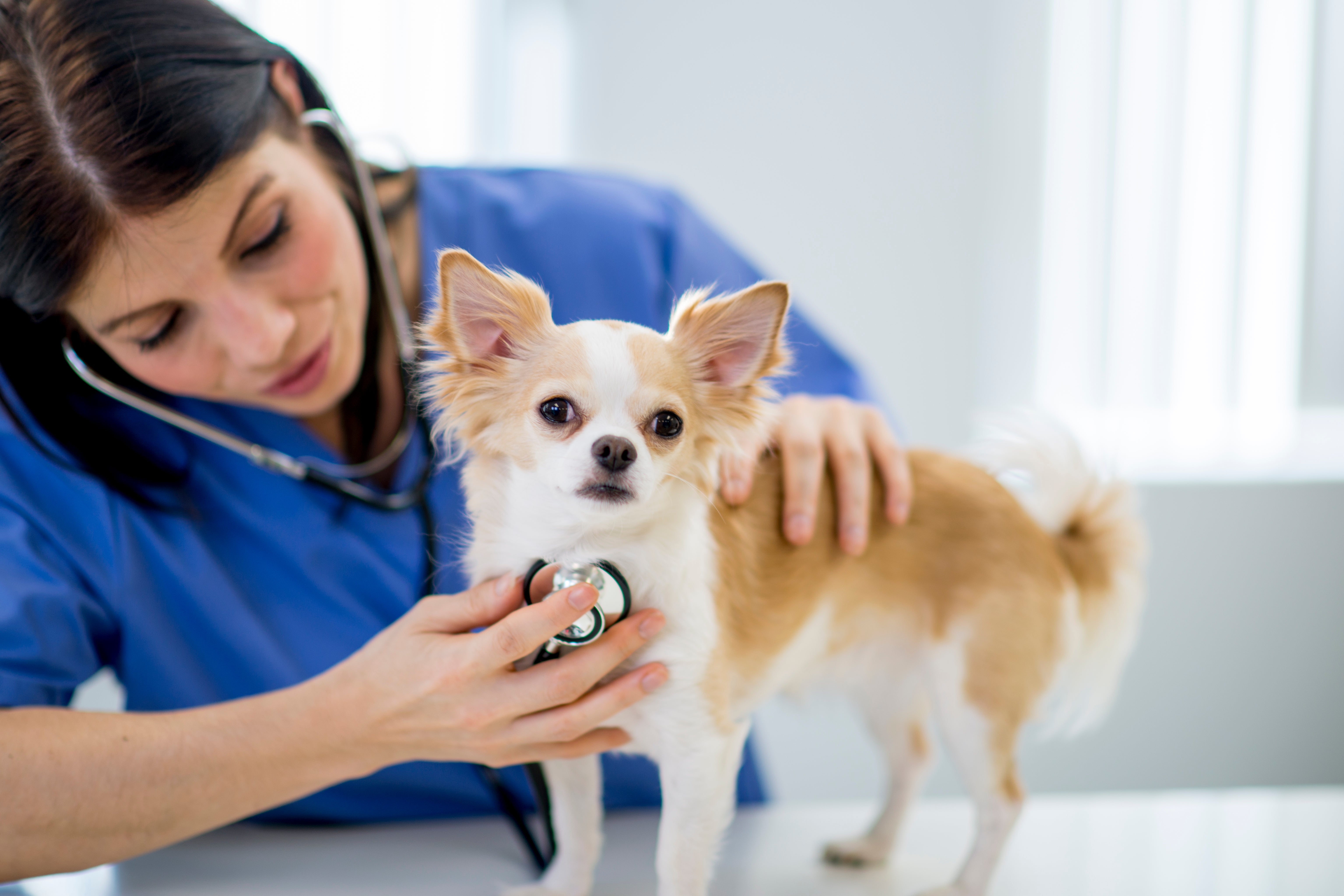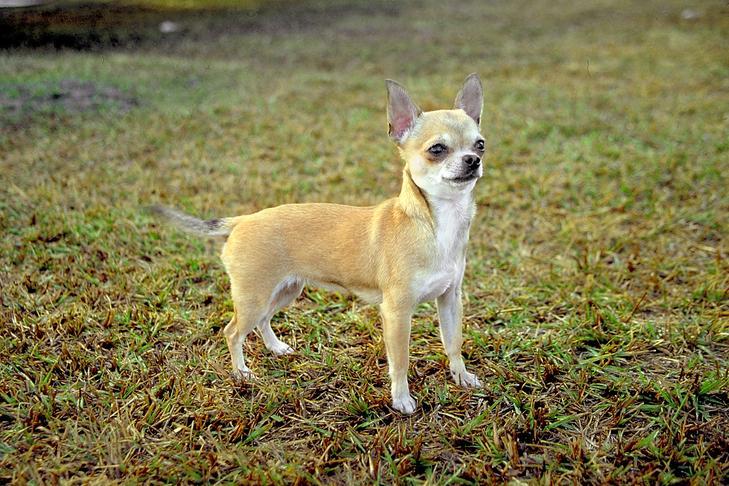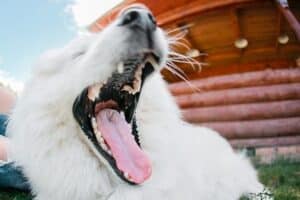Imagine you’re playing ball with your dog, and your pet suddenly yelps in pain, holding a hind leg up and out behind their body. If you are close enough, you may even hear a little pop. A situation like this could be caused by many different things, but that sound is a clue that your dog might have a luxating patella.
Patellar luxation is one of the most common orthopedic conditions diagnosed in dogs. The American College of Veterinary Surgeons found that it occurs in 7% of puppies. But what is a luxating patella, and what do you need to know about it?

What Is a Luxating Patella in Dogs?
A luxating patella is a dislocated kneecap. The patella normally moves smoothly up and down in a deep groove. “Patellar luxation is a condition where the kneecap slips outside of its usual location within the femoral groove when the knee is flexed,” says Dr. Jerry Klein, Chief Veterinary Officer for the AKC. Painful and potentially crippling, patellar luxation in dogs affects one or both hind legs but never the front legs.
According to Dr. Klein, the luxation can be medial or lateral. That depends on whether the kneecap rides on the inner (medial or closer to the midline) portion of the groove or lateral (away from the dog’s midline) if it rides on the outer portion of the knee.
Patellar luxation is considered to be an inherited disease that causes alignment problems during the dog’s skeletal growth. Dogs can be affected from the time they are eight weeks of age. Although the luxation may not be present at birth, the anatomical deformities causing luxations are present. “Patellar luxation can also be caused by a traumatic injury such as a vehicular accident or any accident that causes tearing and stretching of the joint capsule and fascia,” says Dr. Klein.
Are Certain Dog Breeds Predisposed to Patellar Luxation?
Some toy and small breeds are the most susceptible to suffering from a luxating patella. Boston Terriers, Yorkshire Terriers, Maltese, Bichon Frise, Chihuahuas, Pomeranians, and Toy Poodles have been affected more often than other breeds. Researchers believe there may be a genetic reason that these breeds are affected most often, especially when puppies show symptoms.

Despite this, data from the Orthopedic Foundation for Animals (OFA) and the Canine Health Foundation show that occurrences of patellar luxation in medium- and large-breed dogs have been on the rise over the past 10 years. Dog breeds like the Shiba Inu, Chinese Shar-Pei, Flat-Coated Retriever, Akita, and Great Pyrenees were found to be genetically predisposed to this disease, but the reason for this increase is unknown. As more studies are done and more detailed health data becomes available, researchers will hopefully discover more about the causes of increased patellar luxation in larger dogs.
Symptoms of Patellar Luxation in Dogs
The most common symptom is that owners notice that the dog has brief incidents of lameness, holding up their leg for a few steps, seeming to skip, and often extending the hind leg out behind them.
Other symptoms include:
- Weakness in hind legs or hobbling
- Inability to jump
- Reluctance to run or exercise
- Bow-legged or knock-kneed appearance
- Sudden yelps of pain while running or playing
How Is a Luxating Patella in Dogs Diagnosed?

Patellar luxation is found through a physical examination by your vet. “Radiographs of the knee, tibia, and pelvis will often be performed to assess the integrity of those structures,” Dr. Klein explains, noting that these are especially used when your dog shows signs of lameness or hopping in the back limbs.
“Advanced imaging, such as CT scans, as performed on humans, are often now performed on dogs to get a complete assessment of not just the orthopedic structures, but of soft tissues such as the all-important tendons and ligaments which help hold orthopedic structures in their place. Many dogs need sedation or anesthesia to properly perform the procedures.”
There are four grades of patellar luxation. The higher the grade, the more severe the condition.
- Grade I: The patella manually displaces and randomly returns to its normal position with little discomfort.
- Grade II: The patella displaces when the joint is extended and then returns to the normal position.
- Grade III: The patella also displaces with joint extension, but it needs help to be returned to its normal position.
- Grade IV: The patella is permanently out of place and causes the dog a lot of pain.
Treatment Options For Luxating Patella in Dogs
A luxating patella is something that needs veterinary attention. “Although the displacement may be intermittent, a luxating patella in dogs is not going to improve on its own,” says Dr. Klein. “In some cases, especially in Grade I conditions, the dog may be able to tolerate the condition if exercise is restricted, and anti-inflammatory medications help. But as those dogs age, they’re likely to develop arthritis in the knee joint, which will decrease mobility and increase pain.”
A dog with a luxating patella is also predisposed to suffer other knee and leg injuries, like torn cruciate ligaments and degenerative joint disease in the hip.
“Depending on the grade or severity of the luxation, the surgeon may give you various options, from waiting to see if the luxation worsens to performing surgery sooner rather than later,” says Dr. Klein. “Over time, and if the luxation worsens, the kneecap will slip more out of its groove, eroding cartilage and eventually leading to an arthritic joint that causes significant pain. Surrounding structures can also become strained as their use increases to properly stabilize a joint.”

What’s the Prognosis For Patellar Luxation in Dogs?
If your vet diagnoses patellar luxation and recommends surgery, consider scheduling the surgery as soon as you can. The sooner after diagnosis that the surgery is performed, the better your dog’s chance of complete recovery. It is preferred to try to prevent arthritis from developing in your dog’s leg before surgery. Once it does, the surgery won’t be able to eliminate arthritis or the associated pain.
Kneecap instability after surgery is uncommon, reports Dr. Klein. “Most patellar luxation repair surgeries are very successful, especially in smaller dogs. The prognosis may be less favorable if the dog has other concurrent medical or physical issues, such as hip dysplasia or excessive rear quarter angulation.”
After surgery, your vet may prescribe or recommend some way to slow the progression of arthritis and help control any discomfort. Treatments include anti-inflammatories, joint supplements, therapeutic mobility diets, or a combination of these, which could slow the progression of arthritis and help control any discomfort. “Weight reduction is also recommended for overweight dogs. Post-operative physiotherapy may be recommended,” explains Dr. Klein. “Your veterinarian can help you determine the best post-operative plan for your dog.”
Can You Prevent Luxating Patella in Dogs?
There is no way to prevent a luxating patella, but the American College of Veterinary Surgeons recommends against breeding dogs diagnosed with patellar luxation due to the possibility of the condition being hereditary.

“Keeping your dog in good physical shape with appropriate exercise and weight management won’t prevent patellar luxation, but may help prevent arthritis if the condition occurs,” says Dr. Klein. “If the dog has a luxating patella, strenuous exercise is not advised.”







